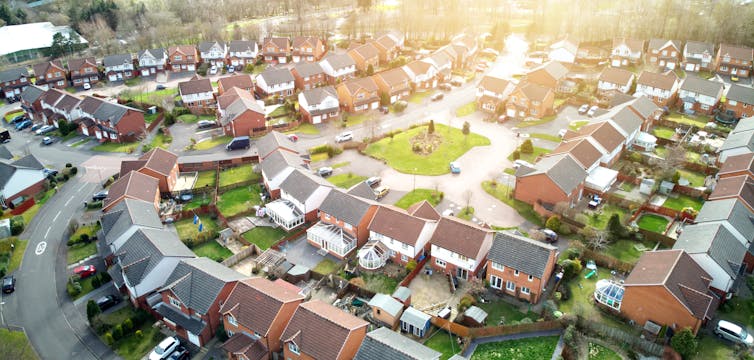
The UK Labour party has announced its intention to reduce its £28 billion green investment pledge to less than £15 billion if elected this year. The political fallout has been been largely focused on the party’s fiscal credibility and leader of the opposition Keir Starmer’s seeming proclivity for U-turns.
A crucial question so far overlooked is what impact the cut would have on public health. The initial pledge included a key home-insulation plan to upgrade 72% – 19m homes – of the UK’s housing stock.
The revised plan, however, replaces that ambitious target with the more ambiguous statement that “millions of homes” will be refurbished. Research has long shown that uninsulated homes have consequences for health, especially for those living in poverty and in poor quality housing. This in turn places an extra burden on an already over-stretched health service.

Shutterstock
Existing government failure
The wider societal cost of poor-quality housing in the UK is estimated at £18.6 billion a year. Such costs, however, are often ignored when housing policy is being developed and implemented.
Labour promises to deliver 1.5 million homes by “blitzing” the planning system, but it has so far ignored the potential consequences for public health.
Of course, the failure to factor in health is by no means unique to Labour policy. It is already embedded in the government’s approach. A recent academic review of government housing and transport policy found that health is notably absent, despite well-established evidence that urban spaces are making us ill. This shows that on the occasions where health is included, it is lower in a hierarchy of priorities compared to other agendas such as growing the economy.
For many years, government housing policy has been shaped by the numeric gap between supply and demand, rather than the type or quality of the housing stock. The mechanisms for delivering have been based on land release and planning reform. Successive housing policies have mentioned involving communities and supporting their health, social, and cultural wellbeing. But there have been no clear targets for ensuring house retrofit and house building positively impact public health.
In his 2010 independent review on how to reduce health inequalities in England, epidemiologist Michael Marmot showed that prioritising health in urban policies, like housing and transport, can have significant health benefits for local populations.
Our research project has shown that health should be made a central factor in all national policy and guidance that shapes urban spaces. The World Health Organization recommends explicitly including health in housing policy – and tracking its impact with recognised metrics. UK politicians have largely failed to respond.
Promising developments
In addition to positive developments in government, such as the Build Back Beautiful Commission, the opposition also has some promising ambitions. Labour is pledging to deliver a “prevention-first revolution”, in which it envisions a pro-active role for government in ensuring that everybody has the building blocks for a healthy life.
In its mission document for health policy, Labour says that retrofitting of millions of homes will “keep families warm rather than living in damp, mouldy conditions that give their children asthma”. The fact that the party is making explicit this link between housing and health signal is a potentially very positive step forward.
However, in all the furore about Labour scrapping its £28 billion pledge, this crucial link to public health has been entirely forgotten. Indeed, while Labour’s environmental policy has been carefully updated to revise and remove various targets, the preventative health agenda retains the now defunct promise to “oversee retrofitting of 19 million homes”. This is perhaps indicative of the extent to which policymakers just don’t think about health when they think about housing.
While the Conservative pledges for the next parliament remain unclear, analysis of their existing policies in government has found a failure to think about or measure the way housing and urban development policis impact health. Instead, it is merely assumed that housing policies will have positive health outcomes. Rather than making such assumptions, policymakers should be putting public health considerations at the centre of all their decision making.
To ensure that the impact any given policy has on public health is measured and acted upon, health needs to be an explicit urban planning policy outcome. It needs to be clearly defined, measurable, and built into policy implementation and political discourse.
It is also important that different government ministries and relevant stakeholders focused on public health, planning and the environment work together more effectively. Unhealthy homes should be a priority for both the housing minister and the health minister.
Healthier people are more economically productive. They have a smaller financial footprint on the NHS. In the long term, better preventative health is a key part of solving some of the UK’s biggest economic challenges, from labour shortages and sluggish productivity growth to stretched public finances.
Too often government policy is not often designed with the long-term in mind. Instead, short-term economic outcomes and political gains are prioritised – to the detriment of public health.
The best way for the government to protect public health is for every department to consider how their work impacts on it. If political and economic calculations about creating, scrapping and rescaling major projects continue to ignore health, however, politicians are likely to continue coming up with the wrong answers.![]()
———————————
This blog is written by Dr Jack Newman, Research Fellow, School for Policy Studies, University of Bristol and Dr Geoff Bates, Lecturer in Social Policy, Research Fellow, University of Bath.
This article is republished from The Conversation under a Creative Commons license. Read the original article.







